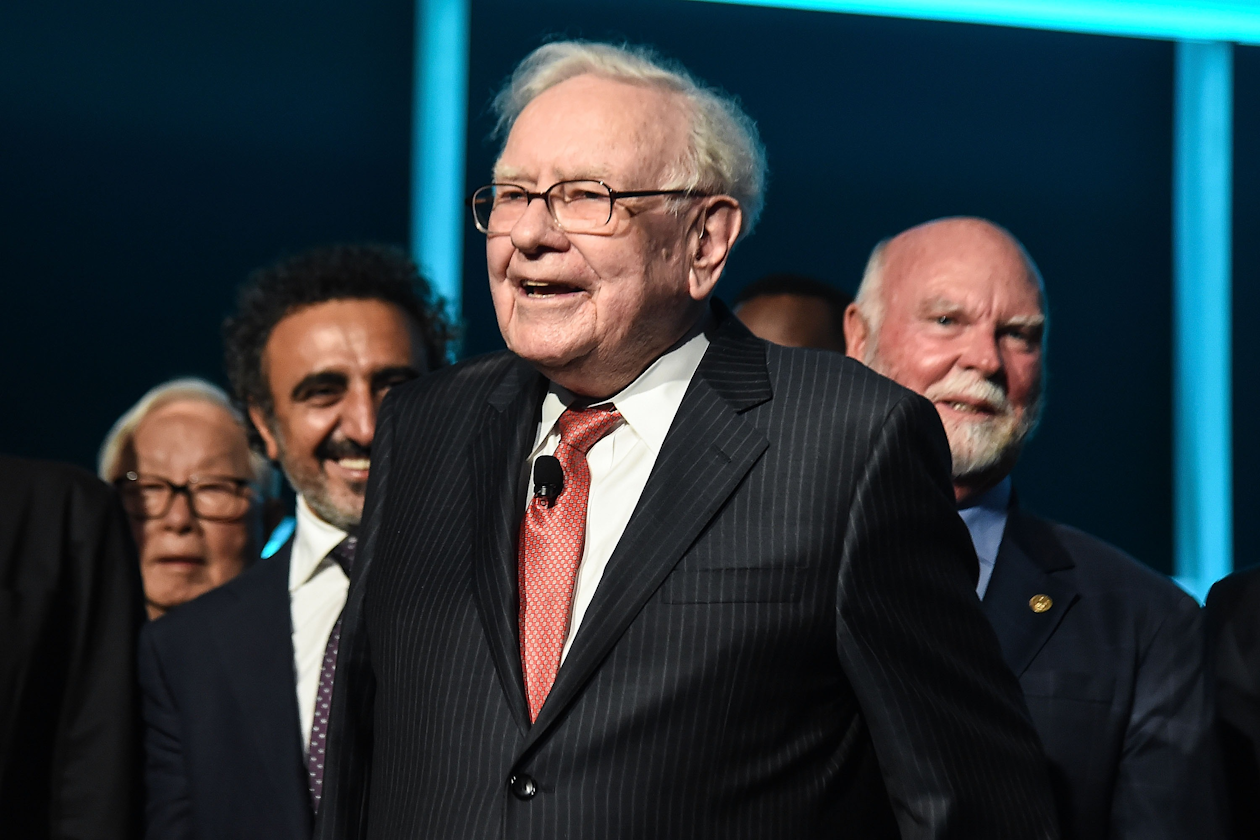News that Warren Buffett is retiring as CEO of Berkshire Hathaway at the end of 2025 has sparked a wave of tributes from investors and admirers around the globe.
That seemed like a timely moment to reflect on the timeless principles that helped Buffett beat Wall Street and become one of the greatest investors of all time.
In this article, we look at Berkshire’s portfolio and highlight three share ideas from it that could help investors grow their wealth over the long term.
This article isn’t personal advice. If you’re not sure an investment is right for you, seek advice. Investments and any income from them will rise and fall in value, so you could get back less than you invest. Past performance isn’t a guide to the future and no dividend is ever guaranteed. Ratios also shouldn’t be looked at on their own.
Investing in an individual company isn’t right for everyone because if that company fails, you could lose your whole investment. If you cannot afford this, investing in a single company might not be right for you. You should make sure you understand the companies you’re investing in and their specific risks. You should also make sure any shares you own are part of a diversified portfolio.
Remember, to buy US shares you must first complete and return a US government W-8BEN form.
American Express
American Express is a key holding for Buffett, and it’s easy to see why.
A strong brand, long heritage, differentiated model, and wide moat are all strengths.
The end-to-end payment network is a key feature – it issues the card, manages the network, and deals directly with merchants.
This setup lets the company keep more of the profit from each transaction, and its focus on the card experience has built a strong reputation with wealthy individuals and businesses.
We think American Express is in a good spot to handle economic bumps.
It has strong financial reserves and wealthier customers who tend to spend and repay more reliably.
However, the company still depends a lot on travel and entertainment, which makes up 28% of its spending volume.
Its commercial card business, while less talked about, is still a dial mover and could face pressure if trade issues persist.
American Express has always focused more on payments than lending, with only about a quarter of its revenue coming from interest income.
However, its push toward younger customers and more lending features has fuelled strong growth, with net interest income rising at a 26% annual rate over the past three years.
That pace is expected to slow from here, but it’s still outpacing peers.
Cardmember loans rose 10% to $139.2bn, helping push net interest income up 11% in the recent quarter.
Credit performance remains solid too – write-downs and default rates stayed steady from last year, showing strong borrower behaviour.
Shareholder returns won’t shoot the lights out, with a prudent dividend policy in play. For long-term holders like Buffett, that’s not an issue.
In fact, reliability is a key strength as we saw during the pandemic when American Express was able to keep its dividend intact.
All in, we think American Express has an attractive mix of defensive qualities, strong branding, and an attractive customer base. A major US spending slowdown is probably the main risk to keep an eye on in the near term.
Berkshire Hathaway
While Warren Buffett might be retiring, his investment philosophy will live on at Berkshire through CEO-elect, Greg Abel.
So, if you want to gain exposure to Buffett’s investment principles on autopilot, owning shares of Berkshire Hathaway is the way to do it.
Berkshire is a holding company that owns a wide variety of businesses.
Operations can generally be split into four main buckets.
Firstly, insurance is the main game at Berkshire. The insurance model is also rather rare. Most other businesses incur costs to build a product or service and then receive money later when it sells.
Insurance flips that dynamic on its head, gaining money up front and finding out much later what the product has cost when policyholders make claims.
We must caution that successfully pricing insurance contracts is difficult, and costs can mount quickly if disasters occur – think wildfires or hurricanes.
Secondly, the money-up-front model has also allowed Berkshire to invest large sums of cash until claims are made, earning a tidy return in the meantime. This cash is typically invested in large, liquid securities like Apple or Coca-Cola, or even short-term government debt due to the high interest rates currently.
Thirdly, there are the large railroads and utilities businesses like BNSF Railway and Berkshire Hathaway Energy. Although these can cost a lot to operate, they’re strong assets with stable cash flows, which should hold up relatively well even if economic conditions deteriorate.
Finally, there are the more than 180 manufacturing, retail and service businesses that Buffett has scooped up over the years. These are private companies, which tend to have some kind of economic moat and strong pricing power.
First-quarter performance has dipped slightly, largely due to insurance operations. But we’d encourage investors to focus on the longer-term picture. Berkshire’s collection of businesses looks well-placed to ride out any potential macroeconomic storm ahead.
Succession risk is something to keep in mind.
While Greg Abel has been a key figure at the company for over 20 years and shares Buffett’s investment philosophy, there’s still no guarantee he will have the same level of success when Buffett steps back from his CEO role.
Coca-Cola
Warren Buffett first bought a stake in Coca-Cola way back in 1988.
Fast-forward to 2025, and it remains one of Berkshire Hathaway’s biggest holdings – epitomising his buy-and-hold strategy.
Of course, Coca-Cola’s brand is one of its core strengths. It boasts a truly global presence in a market that’s unlikely to disappear anytime soon. That brand gives it pricing power, which in turn allows the giant to perform well in a range of environments.
However, what separates the company from most of its peers is its operating model.
Coca-Cola doesn’t actually bottle the drinks itself. This would mean owning a host of bottling plants worldwide, each of which would need to be filled with expensive machinery requiring fairly regular upgrades or replacements.
Instead, Coca-Cola offloads this task to local bottling plants already established in the required region. This allows the group to keep a lid on costs and supports its industry-leading gross margins, which hover around the 60% mark.
This structure has two major benefits.
Firstly, it frees up more cash for Coca-Cola to outspend its peers on marketing, which in turn helps power top-line growth for the bottlers.
Secondly, as bottlers don’t need to invest in marketing, they can invest more resources into upgrading machinery and digitising sales teams to help support best-in-class execution.
The split-role structure makes it very difficult for competitors to challenge Coca-Cola’s dominance.
Tariffs have the potential to disrupt supply chains and push up costs. But given Coca-Cola’s system, with bottling plants all over the world, the impact of tariffs looks manageable.
There’s also an ongoing tax dispute with US tax authorities, with a potential multi-billion-dollar payment on the line. Currently, Coca-Cola appears confident of winning the legal battle, but any negative developments could swing near-term sentiment.
Coca-Cola owns one of the strongest brands in the world. Given the impressive profit growth and strong balance sheet, it remains one of our favourite names in the beverages sector. But investors should remember nothing is immune to ups and downs, especially in the short term.
This article is original Hargreaves Lansdown content, published by Hargreaves Lansdown. It was correct as at the date of publication, and our views may have changed since then. Unless otherwise stated estimates, including prospective yields, are a consensus of analyst forecasts provided by LSEG. These estimates are not a reliable indicator of future performance. Past performance is not a guide to the future. Investments rise and fall in value so investors could make a loss. Yields are variable and not guaranteed.
This article is not advice or a recommendation to buy, sell or hold any investment. No view is given on the present or future value or price of any investment, and investors should form their own view on any proposed investment. This article has not been prepared in accordance with legal requirements designed to promote the independence of investment research and is considered a marketing communication. Non-independent research is not subject to FCA rules prohibiting dealing ahead of research, however HL has put controls in place (including dealing restrictions, physical and information barriers) to manage potential conflicts of interest presented by such dealing. Please see our full non-independent research disclosure for more information.
Open a new HL Stocks and Shares ISA or SIPP today and enjoy 40% off your account charge
Open your ISA or SIPP and add at least £10,000 (including cash and/or transfers) by 30 June 2025
The 40% discount applies between 1 July and 31 December 2025
If you're transferring, your reduced charge will start once your transfer completes, and continue until 31 December 2025
Need more time to apply to transfer? Contact our Helpdesk.
Important: This offer reduces the HL account charge. Our standard account charge is no more than 0.45% a year. Other investment charges may still apply. Buying and selling funds is free. Share and ETF dealing charges apply. See the full ISA offer terms and SIPP offer terms.
Article image credit: Daniel Zuchnik / Contributor via Getty Images.


